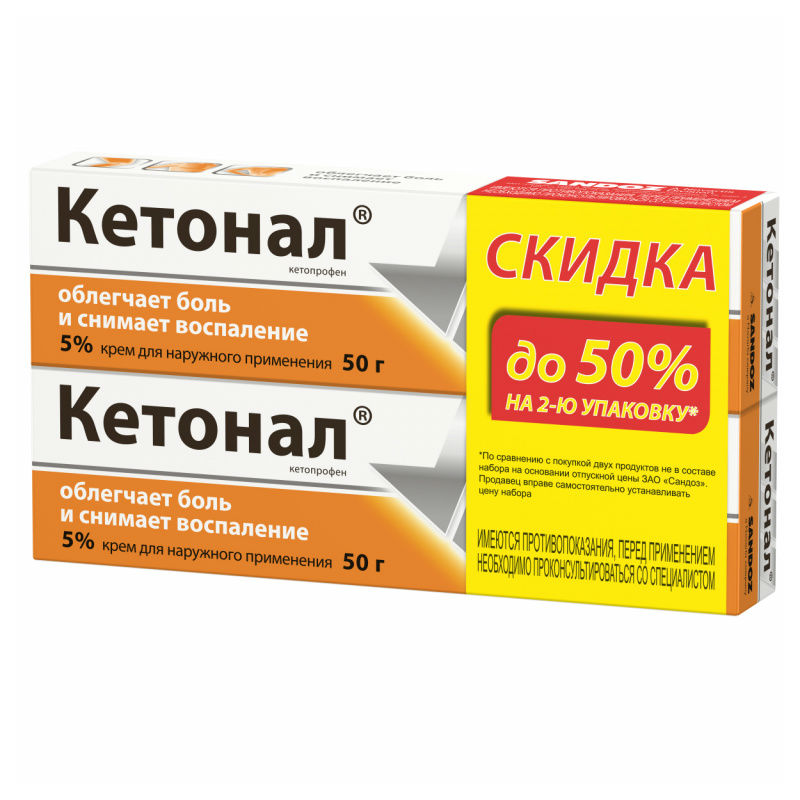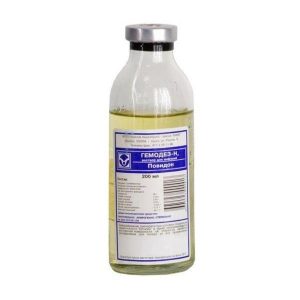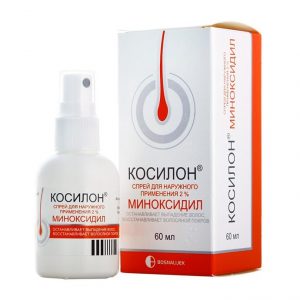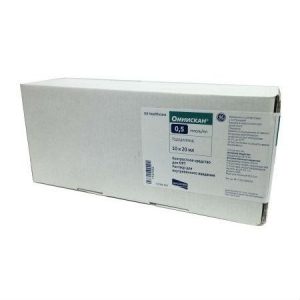Description
Pharmacological action
Ketoprofen is one of the most effective cyclooxygenase inhibitors. It also inhibits the activity of lipoxygenase and bradykinin. Stabilizes lysosomal membranes and inhibits the release of enzymes involved in the inflammatory process.
The main properties of ketoprofen are a pronounced analgesic, anti-inflammatory and antipyretic effect. When using local forms of ketoprofen in case of damage to the ligaments, pain in the back or joints, the analgesic effect of the drug manifests itself 30 minutes after application.
Ketoprofen does not adversely affect articular cartilage.
Pharmacokinetics
Absorption
The penetration of local non-steroidal anti-inflammatory drugs through the skin depends on the physical and chemical properties of the components of the cream. The rate of release and absorption of ketoprofen in the form of a topical cream depends on the excipient of the drug. Compared with the oral form, the relative bioavailability of ketoprofen in the form of a cream is about 5%. Ketoprofen in the form of a cream mainly acts locally and does not have a systemic effect.
Distribution of
Ketoprofen predominantly binds to plasma proteins (99%). It penetrates into the tissues of the joints, including the synovial fluid, and reaches therapeutic concentrations there. In this case, the concentration of ketoprofen in the blood plasma remains insignificant. When applied topically in the form of a cream, the maximum plasma concentration of ketoprofen is observed after 6 hours.
Significant concentrations are present in subcutaneous fat, periarticular tissues, and synovial fluid. The effect of the drug in the tissues lasts up to 12 hours.
Metabolism and Excretion
Ketoprofen is metabolized in the liver to form conjugates, which are excreted primarily by the kidneys. Ketoprofen metabolism does not depend on age, the presence of severe renal failure or cirrhosis. Ketoprofen is gradually excreted by the kidneys.
Indications
Symptomatic therapy – reduction of pain and inflammation – in the following conditions:
osteoarthritis of various localization
periarthritis, tendonitis, bursitis, myalgia, neuralgia, sciatica
injuries of the musculoskeletal system (including sports), bruised muscles and ligaments, sprains, torn ligaments and tendons of muscles.
Contraindications
Hypersensitivity to ketoprofen or other components of the drug, as well as salicylates, thiaprofenic acid or other NSAIDs, fenofibrate, ultraviolet (UV) blockers, perfumes
history of history of history of allergies or allergies
III trimester of pregnancy
children’s age (up to 15 years)
violation of the integrity of the skin in the area of application of the cream (eczema, acne, weeping dermatitis, open or infected wound)
photosensitivity reactions in the history of
exposure to sunlight, including indirect sunlight and UV radiation in the tanning bed throughout the treatment period and another 2 weeks after discontinuation of treatment with the drug.
Caution
You should consult your doctor before using Ketonal ® cream if you have:
impaired liver and / or kidney function
erosive and ulcerative lesions of the gastrointestinal tract
blood disease
bronchial asthma
chronic heart failure.
Special instructions
Avoid contact with cream in the eyes, on the skin around the eyes, mucous membranes.
If skin reactions occur, including those that have developed when used together with octocrylene-containing drugs, treatment should be discontinued immediately.
Patients with asthma in combination with chronic rhinitis, chronic sinusitis and / or polyposis of the nose or paranasal sinuses have a higher risk of allergic reactions with aspirin and / or NSAIDs than the rest of the population.
To reduce the risk of photosensitivity, it is recommended to protect the cream-treated areas of the skin with clothing from UV exposure during the entire treatment period and another 2 weeks after discontinuation. The recommended duration of treatment should not be exceeded due to an increased risk of contact dermatitis and photosensitivity reactions over time.
Wash hands thoroughly after each application.
Composition of
1 g of cream for external use contains:
active ingredient:
ketoprofen – 50.0 mg
excipients:
methyl parahydroxybenzoate (methylhydroxybenzohydroxybenzylpropylpropylpropylpropylpropylpropylpropylpropylpropylpropylbenzoate) 0 mg
isopropyl myristate 50.0 mg,
petroleum jelly (white) 320.0 mg,
elfacos ST 9 30.0 mg,
propylene glycol glyceryl oleate 90.0 mg,
magnesium sulfate 5.0 mg,
purified water 382.5 mg .
Dosage and administration
For external use.
A small amount of cream (3-5 cm) is applied with a light rubbing motion in a thin layer on the skin of an inflamed or painful area of the body in accordance with its area 2 times a day. The duration of treatment without medical advice should not exceed 14 days.
If necessary, Ketonal ® cream can be combined with other dosage forms of the Ketonal ® preparation (capsules, tablets, rectal suppositories, solution for intravenous and intramuscular administration).
The maximum dose of ketoprofen is 200 mg / day.
An occlusive dressing is not recommended.
If you forget to apply the cream, apply it at the time the next dose should be applied, but do not double it.
Side effects
According to the World Health Organization (WHO), unwanted effects are classified according to their frequency of development as follows: very often ( 1/10), often ( 1/100 to <1/10), infrequently ( from 1/1000 to <1/100), rarely (from 1/10000 to <1/1000), very rarely (<1/10000) the frequency is unknown - according to the available data, it was not possible to establish the frequency of occurrence. Immune system disorders frequency unknown: anaphylactic shock, angioedema (Quincke edema), hypersensitivity reactions. Disorders of the gastrointestinal tract is very rare: peptic ulcer, bleeding, diarrhea. Disorders of the skin and subcutaneous tissue infrequently: local skin reactions such as erythema, eczema, itching and burning rarely: photosensitivity reactions, urticaria. Rare reports have been received of more severe reactions, such as bullous or conflicting eczema, which may spread beyond the area of ² ¹ ² ¹application or become generalized. Renal and urinary tract disorders is very rare: impaired renal function in patients with chronic renal failure. If any side effects occur, discontinue use of the drug and consult a doctor. Overdose Overdose is unlikely with external use of the drug. In case of overdose, rinse thoroughly with running water. Stop using Ketonal ® Cream and consult your doctor. In case of ingestion of the drug, systemic adverse reactions may develop. In this case, symptomatic treatment and supportive therapy are necessary as with an overdose of oral forms. Storage conditions At a temperature not exceeding 25 ° C. Keep out of the reach of children. Expiration 5 years. Do not use after the expiration date printed on the package. Deystvuyuschee substances Ketoprofen Conditions of release from drugstores Without prescription Dosage form cream




